London 2012: 20 lesser-spotted things of the Olympics so far
- Published
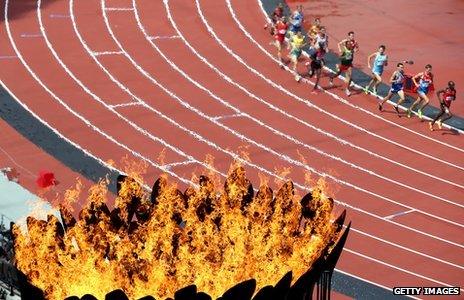
The attention is always on the gold medal performances, roaring comebacks and agonising defeats at the Olympics, but what about all the little details?
Here are some of the less asked questions and lesser-spotted oddities of the Games so far.
Why do athletes always run anti-clockwise?
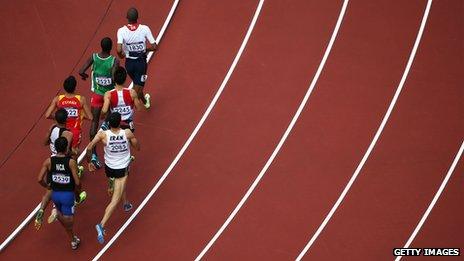
There's a common misconception that the consistently anti-clockwise use of oval athletics tracks is down to the ancient Greeks. It isn't.
According to Paul Cartledge, professor of Greek History at the University of Cambridge, at Olympia and elsewhere in Greece both the running track and the hippodrome (horse-race track) were straight, using up-and-back "laps".
In early modern Olympics - Athens (1896 and 1906), Paris (1900), St Louis (1904) - athletes ran clockwise. This was changed to "left-hand inside" after that (apart from the 1908 London Olympic Marathon, which was switched so that the Royal Family could get a better view).
At the time of the 1896 Games, some but not all track races in England were run clockwise. It's thought that Baron de Coubertin, who founded the International Olympic Committee (IOC) in 1894, might have formed some of his ideas on how to run the Games on ideas based on trips to England.
He visited Much Wenlock in Shropshire - acknowledged as being a birthplace of the modern Olympics - where races were originally run clockwise.
Oxford and Cambridge University were both important in athletics and both ran clockwise - Oxford until the late 1940s and Cambridge until the 1950s.
In Oxford it seemed logical to run clockwise because of local geography, says Jon Roycroft, director of sport at the university.
"One of the early courses was a three lap to a mile track - it went down into a dip and it made sense to run downwards."
So how did anti-clockwise become standard?
According to Running Through the Ages by Edward Seldon Sears, in the 20th Century a number of countries began to settle on the American custom of running counter-clockwise. One theory is that early races were run on horse tracks, which ran in that direction.
Anti-clockwise running had become the norm by the early 1900s and Olympic organisers came under pressure to conform.
According to The History of Oxford's Athletics Club, in April 1948, Roger Bannister, who became president of the athletics at Oxford, said of the athletic track at Iffley Road: "I would not rest until plans were started to replace the old third mile track with a new six-lane, 440 yards track conforming to international specifications."
"It changed sometime between 1950 and 1954 and Bannister's four-minute mile was run in the anti-clockwise direction," says Roycroft.
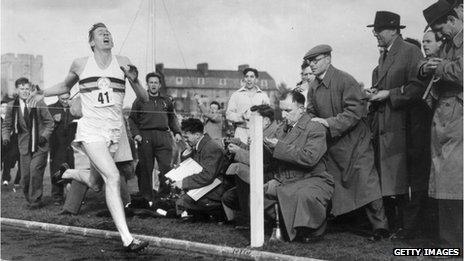
But does running this anti-clockwise make a difference to left or right-legged athletes? Not really, says retired British sprinter John Regis.
"I am right legged - but it wasn't something that came into my mind. It was just part of the sport, you were just trained to run that way. My right leg is a bit stronger and it does a bit more work but not so that any strain is put on either leg."
There are a host of other theories about the domination of anti-clockwise running. Most people are right-handed and some surmise it is easier for them to run anti-clockwise. For most people the right leg is the strongest, with it therefore making sense that the strongest leg covers the slightly longer distance.
You will even hear people contend that the direction of the Earth's rotation makes it faster to run that way - in the northern hemisphere at least.
Why is it Team GB and not Team UK?
While there is jubilation across the UK at the success of Team GB, there are some who less than delighted over the nomenclature.
GB, short for Great Britain, does not traditionally include Northern Ireland. It led to calls for change in 2009, external from the Northern Irish minister responsible for sport, Gregory Campbell. His successor said much the same thing, external.
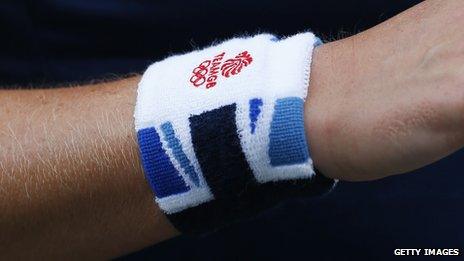
During the current games, Northern Irish ex-Blue Peter presenter Zoe Salmon has suggested, external on Twitter that "Team GBNI" or "Team UK" would be more appropriate names.
The British Olympic Association has resisted the idea of changing the name. It simply states: "Team GB is the Great Britain and Northern Ireland Olympic Team."
And even a change to "Team UK" would not embrace places like Jersey and the Isle of Man that contribute members. Team GB, NI and Crown Dependencies might prove too much of a mouthful for most commentators.
Olympic rings tattoos

There have been lots of them
'Medal' and 'podium' as verbs
You might have it as "winning a medal" or "earning a place on the podium" but since the 2008 Olympics the verbs "medal" and "podium" have been gaining prominence, among commentators at least.
For example, "he'll be hoping to medal" or "she'll know that performance is good enough to podium".
But while some might suspect both to be neologisms, according to the Oxford English Dictionary, it was Lord Byron who first used "medal" as a verb, external.
Twitter users have spent days exploiting the Scooby Doo-inspired "we could have got gold if it wasn't for you medalling kids" gag.
"To medal in [a sporting] context has been on the radar for the Collins English Dictionary, external since the 1990s," says Collins consultant editor Ian Brookes. The earliest is from an Australian newspaper in 1995.
The first example of "to podium" in the dictionary's database is a 2004 story in the Denver Post relating to a skiing article. The writer uses the reference "to podium" and adds an explanation "to finish third or higher".
Turning a noun into a verb is something that's been going on for centuries - it was Shakespeare's Hamlet who says Claudius "out-Herods Herod".
Quick stamps
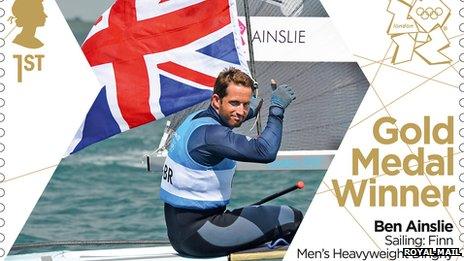
Every Team GB gold medal winner gets their own stamp, and a postbox in their hometown painted gold. But how are the stamps made so quickly?
As sailor Ben Ainslie won his gold medal in the men's Finn class on Sunday, a team of eight Royal Mail designers was on stand-by.
Photographers emailed in a selection of the best images, and the design team then had one hour to review them, find the best picture, crop and refine it, add Ainslie's name, then position it within the template of the six-stamp sheet.
As they rolled off the printers a fleet of 90 Royal Mail drivers loaded them on to their vans and drove off to deliver them to over 500 Post Offices to be on sale by Monday lunchtime.
Why is French the first language of the Olympics?

At the opening ceremony, all the main speeches were first given in French, followed by English.
But why? Is it because French is still considered to be the language of diplomacy? For centuries, political delegates from around the world learned to speak French.
French was the first language of the Olympic movement - which is based in the French-speaking city of Lausanne - thanks to Frenchman Baron de Coubertin, who developed the modern Games in the 1890s.
Today, both English and French are official languages of the Olympics. At ceremonies French is spoken first, then English, then the language of the host nation. If it's an English-speaking country, it's just French first then English. If it's a French-speaking country, it's English first then French.
Of course, some would say the first language of the Olympics should be Greek.
Parents as cult heroes
Archive: Le Clos' father overcome with pride
The focus is always on the athletes, but at this Games parents have become stars too. How many people have watched Chad Le Clos's father Bert pay tribute to his "beautiful boy" in the aftermath of swimming gold.
Bert almost seemed to forget he was on television. His son, South African swimmer Chad, unexpectedly beat Michael Phelps in the butterfly.
Bert burst out: "Look at him, he's crying like me. I love you. Look at him! I love him." Superlatives included "beautiful" and "unbelievable" and Bert apologised when he realised he was live on air. By then, he had won the heart of the nation.
The mother of American gymnast Aly Raisman was less eloquent, shouting "stick it, stick it" throughout her daughter's performance on the uneven bars last weekend. No-one could argue that watching your own child perform isn't agonising to watch, Lynn's peculiar facial and body contortions really caught the eye. Dad Ricky joined in. They squirmed, they gyrated and the video went viral.
Athletes mugging for the camera
Olympic athletes are under extreme pressure. But where the men in the 100m final might once have stared straight ahead, now when the camera passes down the line, each does a small performance.
In Sunday's men's 100m final, Asafa Powell of Jamaica squinted while pouting slightly. America's Justin Gatlin walked off and saluted the crowd. Yohan Blake, who likes to be known as "the beast", shook his whole body before growling at the camera.
The eventual winner Usain Bolt danced as if listening to music before putting two fingers on each side of his head, as if wiping sweat away. He then pointed both fingers to the camera before putting them away into invisible gun holders. Also included in his ritual were a spot of mock DJ-ing and waggling two fingers as if to mime a runner.
Go to about 3:08 of this video (in the UK only) to relive the full routine.
Dr Dre's headphones
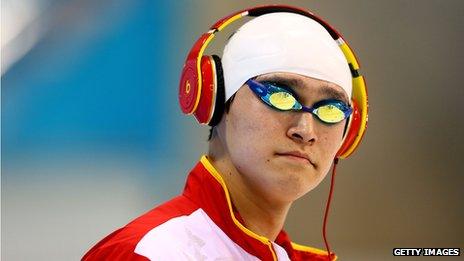
While it was made clear before the games that any attempts at ambush marketing - non-sponsor's efforts to smuggle their branding into the games - would not be tolerated, at least one firm has easily circumvented the rules.
A number of Olympics watchers have picked up on, external the prevalence of rapper Dr Dre's Beats headphones at the Games.
Their ubiquity has been at least in part to free distribution to athletes. They've been particularly noticeable during the swimming, where the camera often lingers on competitors as they "get into the zone".
Medal munching
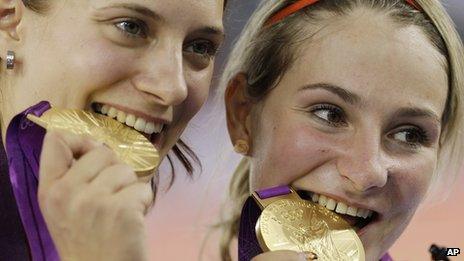
Why is it standard that gold medallists will bite their medals while posing for the cameras?
The gesture apes the age-old test for checking whether a coin is gold. If it's really gold, the teeth should leave a small indentation. Some say the test was primarily for a lead-based fake, which would be even softer than gold.
Now it's become the equivalent at the Olympics of a victorious FA Cup player using the trophy lid as a hat.
So why do they do it? Largely, they are responding to requests from photographers to "kiss it" or "bite it". Many now anticipate it.
American Marti Malloy, who has earned a bronze medal for judo at the current Games, offered to strike the traditional pose.
"I've been working on my bite," she said at the time. "I'm not sure if it should be mean or happy."
The gesture goes back a long way. John Regis remembers doing it at the 1991 world championships.
"When I was a kid, my mother used to buy us those chocolate coins wrapped in gold foil. I was just making sure it wasn't chocolate," jokes Regis.
But there are dangers. In February 2010, during the winter Games a German luger broke a corner off his front tooth after biting down on his medal.
And while the 2012 medal might be one of the biggest ever, the "gold" one only contains 1.34% gold.
The triumph of the tape
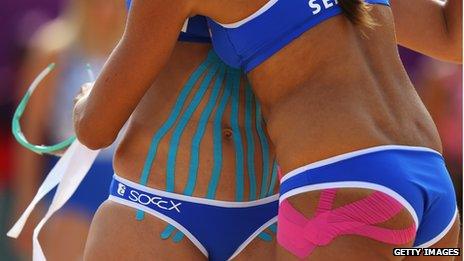
We are now used to seeing athletes' body adorned in coloured tape, but German volleyball player Katrin Holtwick intrigued spectators with her elaborate display. Eight turquoise strips fanned out over her stomach in her match against the Czech Republic on day one of the games. Her team mate Ilka Semmler opted for fluorescent pink tape across her left buttock.
So what does it do?
It is claimed the Japanese-made Kinesio tape can help to mend injuries.
Where standard strapping can provide muscle and joint support, it limits movement and, according to it inventor Dr Kenzo Kase, gets in the way of the healing process by restricting the flow of inflammatory fluids below the skin.
Kinesio tape is supposed to lift the skin to assist this lymphatic flow, reducing pain and swelling.
Science is yet to offer conclusive proof.
Private school domination in Team GB's medals

Andy Murray went to a comprehensive, until he was 14
Lord Moynihan, chairman of the British Olympic Association, has described it as "one of the worst statistics in British sport". Half of Team GB's gold medallists in Beijing were privately educated while 93% of the UK population go to state schools.
It's partly about resources and emphasis - private schools tend to have good sport facilities, the coaches and the time to devote to breeding sporting excellence. Provision is more variable in state schools. All of Britain's equestrian winners in 2008 were privately educated.
But there's a growing view that the UK's top sportsmen and women are becoming ever posher, external. England cricketers used to be state school boys. Today, most are privately educated, as is the case with England rugby players. Even the England football team - traditionally a working class preserve - now has two privately educated midfielders.
Some commentators, like Rupert Murdoch, external, have said it isn't just resources but down to ideology - a fear of competition in state schools.
It's an argument that public schools inculcate values - discipline, self reliance and competition. It's a false premise, John Harris argued in the Observer, external. There is a long roll call of Jessica Ennis, Bradley Wiggins, Greg Rutherford and Mo Farah, among others, that debunks the view that only private schools produce winners. Indeed, after his victory Farah paid tribute to his comprehensive PE teacher.
The success of Andy Murray has been fought over by both sides. He is a comprehensive boy. But his mother Judy sent him away to a tennis academy in Spain aged 14, which cost £25,000 a year.
Until there's a final collation of which education sector won what at London 2012, the debate over schooling is likely to rage on. At the time of writing, private school athletes had won 32% of Team GB's medals, external.
Patriotic nail art

Wild nail art, much beloved of teenage girls, has taken precedence at the 2012 Games, with swimmers, archers, volleyball players and tennis players - female that is - showing it off. In many cases, the mini canvasses have sported painted flags.
British swimmer Rebecca Adlington's tiny union jacks stood out against the backdrop of the bronze medal she was holding. Mireia Belmonte, Spanish 800m freestyle silver medallist, expressed envy.
"I told her I liked her nails with the flag [of the UK] on. I was amazed by them and I wanted to do the same."
US gold medal swimmer Allison Schmitt took a slightly more oblique approach to her patriotism - red polish with a blue standout nail on one hand, and blue nails with a red statement nail on the other. She skipped the white, but the audience got the message.
The black card

Football fans are used to yellow and red cards, but the black card will be a new one to many sports fans.
They were seen on one occasion last week - when Olympic badminton head referee Torsten Berg issued one to four pairs of players accused of trying to lose their matches in an attempt to manipulate the draw for the knockout. Is this an Olympic-wide card or specific to particular sports?
It terms of Olympic events, it's only badminton and fencing that use the black "disqualification" card.
In the latter, a black card is followed by a disciplinary hearing. In the case of the Chinese team, two South Korean teams and team from Indonesia, the black cards were withdrawn on the promise of better play from the teams, but a later hearing disqualified them anyway.
A fencer receiving a black card is also expelled from the competition. South Korean fencer Shin Lam was caught up in dispute, which reportedly raised fears, external that she could face a black card following her defeat in the semi-finals. Shin looked to have beaten Heidemann only for the clock to be reset with one second remaining of sudden death, and Heidemann then managed to score a decisive hit for a 6-5 win. She remained on the piste for more than an hour while protests were made on her behalf and was then escorted off amid fears of disqualification, according to reports. She was later offered a "special" award.
People humming Chariots of Fire
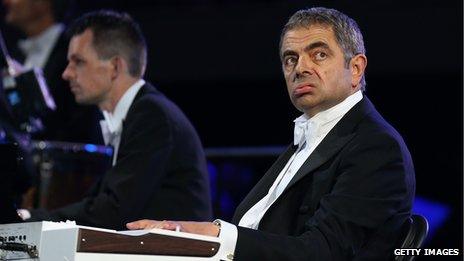
Thanks to that memorable collaboration between Sir Simon Rattle and Mr Bean at the opening ceremony, Chariots of Fire has become the song of London 2012.
Repeatedly blasted out between swimming races, in the velodrome, in the stadium, and before medal ceremonies, it has become loved for its championship spirit, and loathed for its irritating catchiness.
The simplicity of the opening notes also makes it a very satisfying song to hum - as many people have discovered.
"Couldn't help grinning at the man who kept whistling 'Chariots of Fire' on the train. Very loud and completely unaware!!" said @DanielRyan on Twitter.
While @HilaryPhelps adds: "I will have the Chariots of Fire song stuck in my head for weeks. Anyone else?"
Pink is everywhere
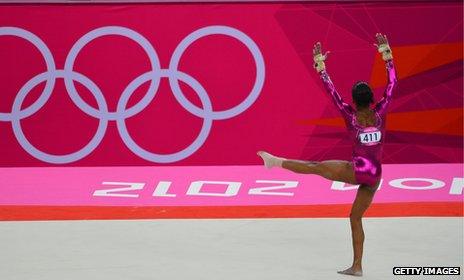
Pink is one of the colours that has been used to "brand" this Olympics, along with blue, green, and orange.
Everything from the floor at the gymnastics to the cloud of dust at the skeet shooting has been pink.
"It was weird and we walked into the arena, and we were like, whoa," noted 16-year-old gymnast Gabby Douglas. "This is the worst colour combo ever. It makes your eyes feel crazy."
In terms of branding, pink is supposed to signify friendship, warmth and well-being. "It's well known that is you expose people to it for a short period of time it calms them down," says Jonathan Gabay, author of The Brand Messiah.
"As a background, it's really odd - yet another mess in terms of branding," says Gabay. "If you are in England or the US, you would expect to see a predominance of red, white and blue."
But perhaps that's the point. It's about neutrality, about not nailing your colours to any mast, as it were - making athletes from the four corners of the world feel at home. After all, how many countries have pink among their national colours?
Standout bodies
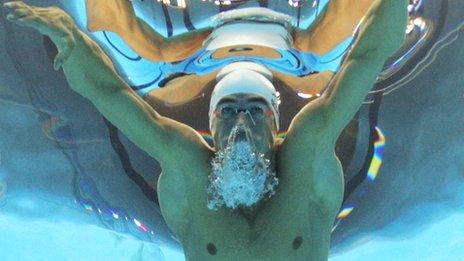
When it comes to the Olympics there are no end of extraordinary physiques. But some have been more commented on than others. Italian breaststroker Fabio Scozzoli and his amazing underarm muscles and German cyclist Robert Forstemann and his truly remarkable thighs.
An underwater picture of 23-year-old Scozzoli taken at the Aquatics centre during the 100m breaststroke final show the fully flexed muscles resembling a pair of "wings". Some have even labelled him a "human stingray".
New Zealand cyclist Greg Henderson documented a spontaneous "quad off" between Forstemann and German cyclist Andre Greipel. The result is on Henderson's Twitter page, external, with the Twitter feed, noting: "You thought Greipel has a big set of legs…"
The wave of orange Dutch fans

One nation is more easily spotted than any other at the games. The orange of the Dutch fans means blocks of them are visible in the background at many events.
Their fan attire does not stop at Olympic events - they can be seen around London, and congregating at Alexandra Palace on their way to a Dutch supporters pub.
During sporting events in the Netherlands you would see streets, cars and shops decorated in orange. Abroad they make do with decorating themselves.
Lochte's grill
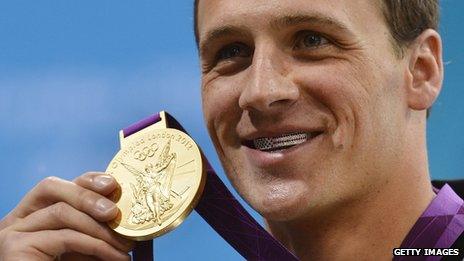
When the flag manicure is no longer unusual, and the Olympic ring tattoo is inked on to so many bodies, it takes a dramatic statement for the fashion conscious athlete to stand out.
Swimmer Ryan Lochte has one answer. The American wears a jewel encrusted "grill" or guard over his teeth when he collects a medal.
It was reported that Lochte was told to take off his $25,000 diamond-and-ruby-encrusted American flag grill when he went to collect his gold medal for the 400-metre Individual Medley, external.
But he was proudly wearing it immediately afterwards to pose for photographs, biting on his medal with his twinkly teeth.
Reportedly designed by Houston rapper Paul Wall, the grill was made especially for Lochte to wear at the London Olympics.
2012 typeface
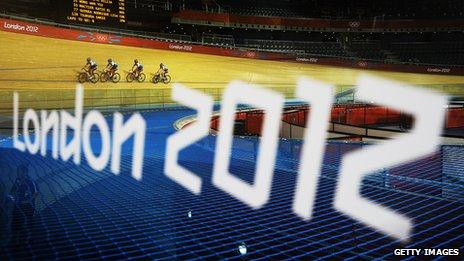
The London Olympics typeface - 2012 Headline - has been everywhere at the Games but you won't find it anywhere else.
While the logo prompted a huge controversy when it was unveiled, the graffiti-inspired typeface has had an easier ride.
"It's in a strange class of its own, certainly not part of a type family," says Simon Garfield, author of Just My Type.
"I'm adoring the Olympics and enthralled by our achievements, but I'm still trying to avert my eyes from that typeface - particularly the numbers, which look like they've been cut out with gaffer tape.
"I will admit it's a brilliant piece of corporate branding - I don't think anyone will confuse London 2012 with any other games past or future."
Wired.co.uk this week takes a historic look at past Olympic typefaces and logos, external and describes 2012 Headline as "an odd combination of characters vaguely looking like a melding of Greek stone carving and graffiti lettering. All letters are angular and slanted - with no curved strokes, save the cap and lowercase 'o' - which are also upright in design."
Reporting by Kathryn Westcott, Lucy Townsend, Melissa Hogenboom, Tom de Castella, and Finlo Rohrer
Readers contacted us with more Olympic oddities.